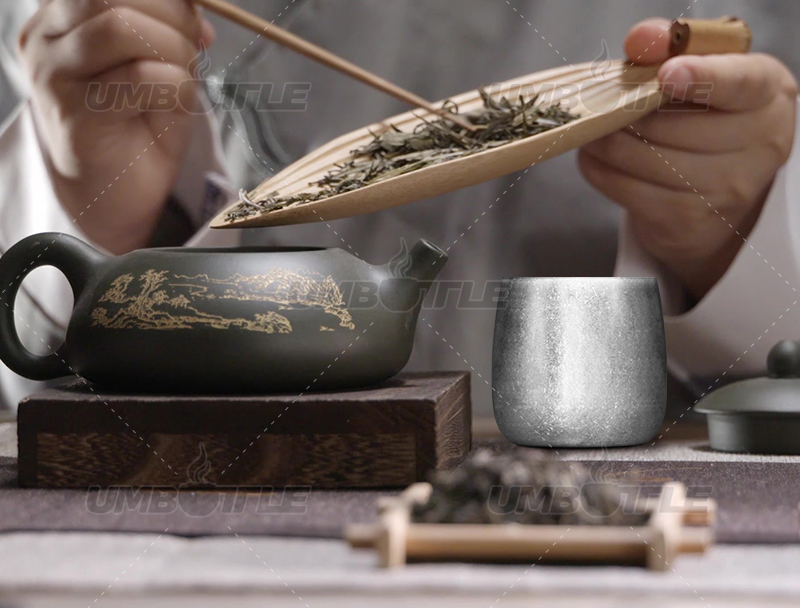What is Tea Culture?
Chinese tea culture is one of the treasures of traditional Chinese culture, with a long history and profound historical heritage. http://www.umbottle.com/ProductsDetail-VB-10447.htmlTea culture is not just a way of drinking tea; it is a pursuit of spirit and a philosophy of life. In Chinese tea culture, there are several aspects to consider:
Origin and Evolution of Tea: China is the homeland of tea, and its origin can be traced back to around 2737 BC during the time of Emperor Shennong. As history progressed, tea gradually entered the imperial court and the literati class, becoming an essential part of the refined life of scholars. http://www.umbottle.com/ProductsDetail-VB-10447.htmlThe evolution of tea, from simple boiling and brewing to the later art of tea appreciation and the in-depth exploration of different types of tea and brewing methods, showcases the rich and colorful aspects of Chinese tea culture.
Elegance of Tea Ceremony: The tea ceremony is a significant manifestation of Chinese tea culture, emphasizing etiquette, respect, and tranquility. The tea ceremony includes both hot and cold tea, and the diverse nature of different teas contributes to the richness of the ceremony. http://www.umbottle.com/ProductsDetail-VB-10447.htmlDifferent regions and tea enthusiasts have unique perspectives and emphasis on the tea ceremony, adding depth to the cultural significance of tea.
Tea Utensils and Crafting Techniques: The selection and crafting techniques of tea utensils are crucial aspects of tea culture. http://www.umbottle.com/ProductsDetail-VB-10447.htmlTraditional tea utensils include teapots, tea cups, etc., and their shapes, materials, and crafting techniques have strict requirements. For example, the purple clay teapot, highly esteemed in Chinese tea culture, is made from special clay in Yixing, providing breathability and adsorption capabilities that enhance the richness of the tea.
Classification and Evaluation of Tea: Chinese tea culture places great emphasis on the classification and evaluation of tea leaves. Chinese tea is categorized into six main types: green tea, black tea, yellow tea, white tea, oolong tea, and dark tea. http://www.umbottle.com/ProductsDetail-VB-10447.htmlEach type has its unique flavor and characteristics. Tea evaluation is a refined skill where tea enthusiasts assess tea based on appearance, aroma, liquor color, taste, and tea leaves, contributing to a deep understanding and appreciation of good tea.
Artistic and Poetic Aspects of Tea: Chinese tea culture emphasizes the artistic and poetic aspects of tea. http://www.umbottle.com/ProductsDetail-VB-10447.htmlThe beauty of tea art is often portrayed as a spiritual realm beyond materialistic concerns. In the tea ceremony, tea enthusiasts immerse themselves in a quiet, profound, and elegant atmosphere by observing the appearance of tea, smelling its aroma, and savoring its taste. Ancient poets often used tea as a subject in their poems, expressing a deep love for tea culture.
Regional Characteristics of Tea Culture: With vast geographical diversity, different regions in China present diverse tea cultures. Teas like West Lake Longjing, Wuyi Rock Tea, and Pu'er tea all have distinct regional characteristics. http://www.umbottle.com/ProductsDetail-VB-10447.htmlThe various expressions in tea varieties, production techniques, and tea ceremony practices reflect the diversity of regional cultures.
Tea and Life Philosophy: Chinese tea culture is not just a way of life; it is also a pursuit of life philosophy. During the process of brewing tea, tea enthusiasts seek not only the fragrance of tea but also a sense of inner peace and tranquility. http://www.umbottle.com/ProductsDetail-VB-10447.htmlDrinking tea is considered a process of self-cultivation and refinement, allowing individuals to find serenity amidst the busyness of life.
Contemporary Development of Tea Culture: With continuous social development and progress, Chinese tea culture is constantly innovating and evolving. Tea culture is no longer confined to traditional brewing methods; new forms of tea-drinking culture continue to emerge. http://www.umbottle.com/ProductsDetail-VB-10447.htmlTea restaurants, teahouses, and various forms of tea culture venues are prevalent in modern cities. Meanwhile, tea has found broader applications in contemporary society, such as tea culture festivals and tea art performances, bringing new vitality to tea culture in the modern world.
The rich connotations of Chinese tea culture manifest in various aspects, including the origin and evolution of tea, the elegance of tea ceremony, tea utensils and crafting techniques, classification and evaluation of tea, the artistic and poetic aspects of tea, regional characteristics of tea culture, tea and life philosophy, and the contemporary development of tea culture. http://www.umbottle.com/ProductsDetail-VB-10447.htmlTogether, these aspects form a vast and rich system of tea culture, providing a platform for people to savor life and cultivate their inner selves.

Dongguan Zhanyi Commodity Technology Co., Ltd. specializes in the production of metal cups, plastic cups, coffee cups, suction mug, lunch boxes, food jar, travel mugs, portable water bottles, sports bottles, home life desktop trash cans, thermos bottles, etc.These products are all our annual exports, and are recognized and loved by the US, Europe, Australia, Japan, South Korea, Taiwan, Hong Kong and other consumers. Support for small quantity order, fast customization.